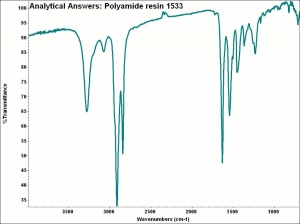Nylon resin
Description
A general name for a family of synthetic long-chain polyamide resins. Nylons are classified with system in which the word nylon is followed by a numeral indicating the number of carbon atoms in the monomer, such as Nylon 6. When two numbers follow, such as nylon 6,6, the polymer was made from a diamine (first number) and a dibasic acid (second number). Nylon 6,6 was first made in the early 1930s by W. H.Carothers as a textile fiber called fiber #66; the name nylon was coined in 1938 by DuPont. Nylons are thermoplastic resins that are characterized by their excellent tensile strength, toughness, elasticity, and abrasion resistance. They have good electrical resistance but can accumulate static electricity. Nylons also have low water absorption and have of good affinity for dyestuffs. Nylon fibers are compatible with wool and cotton and are often used in blended textiles to increase wear and crease resistance. Nylons are also used paints, films, foams, and molded parts.
Synonyms and Related Terms
polyamide resin; Akulon; Caprolan: Celon; Durethan; Nylon 66; Nylon #66; fiber 66: Tynex; Rilsan®; Nylon (Dan., Deut., Fr., Ned., Nor., Pol., Sven.); nailon,nilón (Esp.); PA; polyamide resin; Nylon 66; Nylon #66; fiber 66; nylon (Dan., Deut., Fr., Ned., Nor., Pol., Sven.); nailon, nilón (Esp.);
Examples: Nylon® [Du Pont]; Rilsan® [Arkema]; Akulon® [Quadrant]; Aegis® [Honeywell]; Caprolan: Celon; Durethan® [Lanxess]; Tynex® [Du Pont]
Applications
Risks
Potential degradation products are carbon monoxide and cyanogen. Degraded by sunlight. Flame resistant, melting rather than burning. Resistant to insects and microorganisms.
Physical and Chemical Properties
Resistant to alkalis, and insoluble in most organic solvents. Soluble in hot phenols, cresols and mineral acids. Moisture regain = 4.2-5.0%.
| CAS | 63428-83-1 |
|---|---|
| Density | 1.14 |
| Refractive Index | 1.53 |
Comparisons
Physical Properties for Selected Thermoplastic Resins
General Characteristics of Polymers
Sources Checked for Data in Record
- E. Richardson, G.Martin, P.Wyeth. (2014) Effects of heat on new and aged polyamide 6,6 textiles during pest eradication. Polymer degradation and stability 107 262-269. link
- Catherine Sease (1981) The Case against Using Soluble Nylon in Conservation Work Studies in Conservation Vol. 26 (3) 102-110; DOI: 10.2307/1505851
- 'The History of Nylon' by Prof Trossarelli (Please scroll down if you don't initially see anything) pdf
- G.S.Brady, Materials Handbook, McGraw-Hill Book Co., New York, 1971 Comment: p. 553
- Theodore J. Reinhart, 'Glossary of Terms', Engineered Plastics, ASM International, 1988
- Richard S. Lewis, Hawley's Condensed Chemical Dictionary, Van Nostrand Reinhold, New York, 10th ed., 1993
- Matt Roberts, Don Etherington, Bookbinding and the Conservation of Books: a Dictionary of Descriptive Terminology, U.S. Government Printing Office, Washington DC, 1982
- Encyclopedia Britannica, http://www.britannica.com Nylon. Retrieved May 25, 2003.
- Website address 1 Comment: www.nswpmith.com.au/historyofplastics.html
- Wikipedia: http://en.wikipedia.org/wiki/Nylon (Accessed Feb. 10, 2006)
